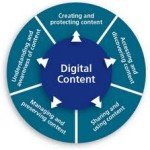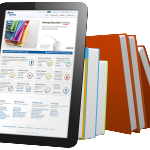Digital Learning
Digital learning is any instructional practice in or out of school that uses digital technology as a teaching and learning aid. It encompasses a wide range of digital tools and practices, including instructional content, interactions, data and assessment systems, teaching & learning platforms, virtual on-line courses, adaptive software, personal learning enabling technologies, and student data management systems.
Public schools and districts have been using a wide variety of digital content and instructional software for many years. We have seen many examples of innovative and effective use of these tools within instructional programs from the early grades through high school, from core subjects, to advanced learning and to credit recovery. Of the nearly 55 million K–12 students in the United States, about 47 million (85%) attend non-charter public schools in about 13,500 school districts (see: Public Schools). Most districts are using some form of digital learning, which may range all the way from full-time online programs, to supplemental online courses, online courses that include some degree of face-to-face instruction, digital learning enhancements to classroom instruction, and to skills software used in math, English Language Arts (ELA), and other classes.
Most districts are using some form of digital learning, which may range all the way from full-time online programs, to supplemental online courses, online courses that include some degree of face-to-face instruction, digital learning enhancements to classroom instruction, and to skills software used in math, English Language Arts (ELA), and other classes.
The roots of much of the current digital learning activity are in computer-assisted instruction (CAI) (see: Computer Supported Collaborative Learning) that pre-dates the World Wide Web. While the schools and suppliers who were primarily online adjusted their products and services to account for onsite, school-based use and support, the suppliers with roots in computer-assisted instruction were moving their computer-assisted content into a web-based environment. (see: Keeping Pace with K-12 Online Learning report – 2015). (Kpk12)
The key benefits of CAI and virtual learning were largely complementary, and in recent years online learning and CAI have converged. School districts are providing both types of options, and they are often both managed at a district level by one district office. In some districts the online learning program serving students at home and in schools is closely tied to efforts to support district schools in their move to digital content and devices. This dynamic is increasingly common in traditional school districts. Much like today’s musical artists who often sample other music to re-mix, re-envision, and re-create new songs and sounds, practitioners today are taking different elements of digital learning, with varied backgrounds and sources, for use in their own schools, programs, and classrooms.
Understanding the layers and their relationships in the universe of suppliers and users is critical for comprehending the digital learning landscape. For virtual and digital learning, suppliers are entities that provide online and digital learning products and services to schools, and sometimes directly to students, but usually coordinated and monitored by a school. A supplier is not responsible for a student’s academic activity and performance and is not authorized to do so. They do not own the transcript of a student, administer state assessments, assign grade levels, or offer diplomas. Only authorized schools can grant credit towards grade level advancement and confer diplomas (Kpk12).
Digital Learning Transformation
According to Johnson, et al, (2014) policy makers and key thinkers across the world are aware of the demand for forward-thinking learning models. The Global Education Leaders’ Program (GELP) is one such endeavor to foster more progressive pedagogies, curricula, and assessment methods with Wicked Challenge (p. 29) the goal of increasing higher order thinking and skills within students (3). Led by the Innovation Unit in the U.K. and sponsored by Cisco, The Bill and Melinda Gates Foundation, the Ellen Koshland Family Fund, and Promethean, GELP unites a group of policy makers, education system leaders, consultants, and other stakeholders with the common mission of transforming educational practices – regardless of whether the learning institution is public or charter. GELP teams have been deployed in participating countries and cities to influence change at the local, national, and international levels (4).
 In light of major initiatives that demonstrate the value of soft skills like collaboration and critical thinking for K-12 students, there is an opportunity for universities to expand the ways in which students can be admitted. In Australia, many admission councils at universities, such as Newcastle University (5) and University of Sydney, (6) have acceptance policies that include alternative entry from students who did not formally graduate from high school or are athletes with rigorous travel schedules but can demonstrate their knowledge through pre-college courses, tests, or other means.
In light of major initiatives that demonstrate the value of soft skills like collaboration and critical thinking for K-12 students, there is an opportunity for universities to expand the ways in which students can be admitted. In Australia, many admission councils at universities, such as Newcastle University (5) and University of Sydney, (6) have acceptance policies that include alternative entry from students who did not formally graduate from high school or are athletes with rigorous travel schedules but can demonstrate their knowledge through pre-college courses, tests, or other means.
Finally, there is a need for all models of education to take into account a variety of student needs. For example, some students simply cannot travel to brick-and-mortar institutions due to physical restrictions or disabilities. Online learning is increasingly being viewed as a vehicle for social equality, reaching disadvantaged students as well as those in rural areas. The “Bednet” in Belgium, for example, is an organization that serves children who are suffering from long-term and/or chronic illness (7). Similarly, the Wereld School in the Netherlands provides online, alternative education for students with special needs that may not be accommodated by the traditional school system (8).
Johnson, L., Adams Becker, S., Estrada, V., and Freeman, A. (2014); NMC Horizon Report: 2014 K-12 Edition. Austin, Texas: The New Media Consortium.
- https://www.flvs.net/
- http://www.usnews.com/education/blogs/high-school-notes/2012/10/24/ states-districts-require-online-ed-for-high-school-graduation
- http://www.innovationunit.org/our-projects/projects/transformingeducation-systems-around-world-global-education-leaders-program-g
- http://www.innovationunit.org/sites/default/files/GELP Prospectus 2011-2013_0.pdf (PDF)
- http://www.newcastle.edu.au/future-students/high-school-students/gettingin
- http://sydney.edu.au/future-students/domestic/undergraduate/access-sydney
- http://www.virtualschoolsandcolleges.info/presentation/bednet-onlineschool-education-children-and-youngsters-medical-needs-els-janssens
- http://www.wereldschool.nl/about-the-wereldschool
Today many technologies can be, and are, used in e-learning, from blogs, to collaborative software, and virtual classrooms. Most eLearning situations use combinations of these techniques. eLearning can make a big difference in education. Under the monitoring of their parents children can develop their knowledge, skills and perception of the world using the interactivity of the new media. Everyone must have a basic knowledge of technology and its use to function in modern society.

Recent Comments